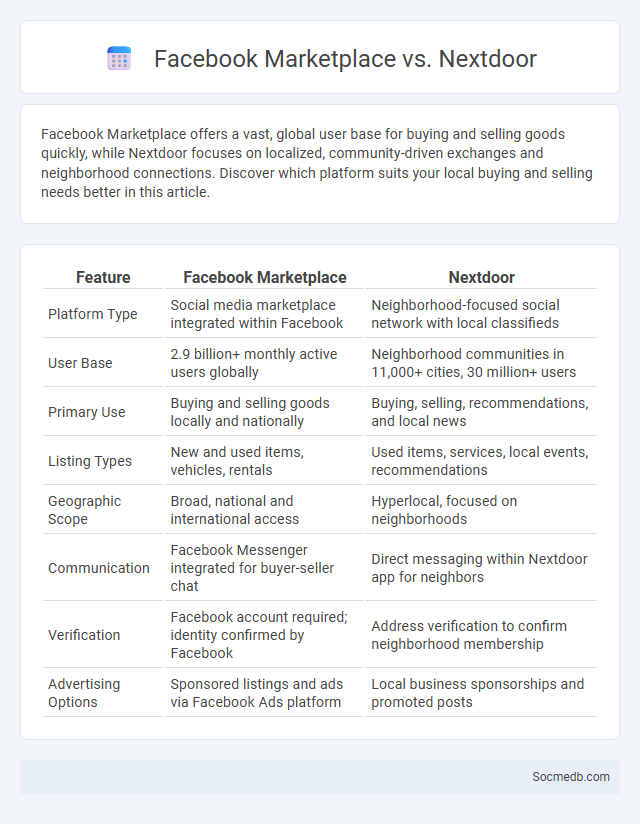
Photo illustration: Facebook Marketplace vs Nextdoor
Facebook Marketplace offers a vast, global user base for buying and selling goods quickly, while Nextdoor focuses on localized, community-driven exchanges and neighborhood connections. Discover which platform suits your local buying and selling needs better in this article.
Table of Comparison
| Feature | Facebook Marketplace | Nextdoor |
|---|---|---|
| Platform Type | Social media marketplace integrated within Facebook | Neighborhood-focused social network with local classifieds |
| User Base | 2.9 billion+ monthly active users globally | Neighborhood communities in 11,000+ cities, 30 million+ users |
| Primary Use | Buying and selling goods locally and nationally | Buying, selling, recommendations, and local news |
| Listing Types | New and used items, vehicles, rentals | Used items, services, local events, recommendations |
| Geographic Scope | Broad, national and international access | Hyperlocal, focused on neighborhoods |
| Communication | Facebook Messenger integrated for buyer-seller chat | Direct messaging within Nextdoor app for neighbors |
| Verification | Facebook account required; identity confirmed by Facebook | Address verification to confirm neighborhood membership |
| Advertising Options | Sponsored listings and ads via Facebook Ads platform | Local business sponsorships and promoted posts |
Understanding Facebook Marketplace: Key Features
Facebook Marketplace offers a user-friendly platform for buying and selling goods locally, featuring categorized listings that simplify product searches. It integrates messaging tools to facilitate direct communication between buyers and sellers, enhancing negotiation and transaction transparency. The platform's location-based filters and shipping options expand market reach while maintaining convenience and safety for users.
Exploring Nextdoor: Community-Centric Marketplace
Nextdoor serves as a hyperlocal social media platform connecting neighbors through a community-centric marketplace facilitating the exchange of goods and services. Its unique geolocation-based network enhances local economic growth by promoting small businesses and personal transactions within trusted neighborhood circles. By fostering real-time communication and verified user profiles, Nextdoor reinforces community engagement and collaboration at a grassroots level.
Marketplace Overview: What Sets It Apart?
Social media marketplace platforms distinguish themselves by integrating user-generated content with e-commerce features, creating seamless shopping experiences within social networks. Advanced algorithms personalize product recommendations based on user behavior and social interactions, enhancing engagement and conversion rates. Real-time communication tools and secure payment systems facilitate trust and convenience, making social media marketplaces highly effective for both buyers and sellers.
User Demographics: Who Uses Each Platform?
Facebook attracts primarily adults aged 25-54, with a strong presence among users aged 35-44, making it ideal for reaching a broad, established audience. Instagram is favored by younger demographics, especially users aged 18-34, with significant engagement from millennials and Gen Z who prefer visual and lifestyle content. Understanding these user demographics helps you tailor content strategies effectively to target the right platform for your audience.
Listing and Selling Process Compared
Listing products on social media platforms involves creating detailed posts with high-quality images, engaging descriptions, and relevant hashtags to attract potential buyers. The selling process on social media includes real-time interactions through comments, direct messages, and integrated payment options, facilitating seamless transactions. Effective use of social media analytics helps sellers optimize listings and target audiences for improved conversion rates.
Safety and Privacy Measures Across Platforms
Protecting your personal information on social media platforms requires understanding the privacy settings each platform offers, such as Facebook's customizable audience controls and Instagram's two-factor authentication. Regularly updating passwords and enabling features like end-to-end encryption on messaging apps, including WhatsApp, further enhance your digital safety. Monitoring app permissions and being cautious about third-party app integrations also help safeguard your data from unauthorized access.
Pricing, Fees, and Payment Options
Social media platforms offer diverse pricing models, including free access supported by advertising and premium subscriptions with enhanced features. Fees vary depending on the platform's monetization strategy, with options such as in-app purchases, promoted content fees, and membership tiers. Payment options typically include credit/debit cards, PayPal, and mobile payment systems, ensuring user convenience and global accessibility.
App Interface and User Experience
A well-designed social media app interface enhances user engagement by ensuring intuitive navigation and clear visual hierarchy. Optimizing loading speed and minimizing clutter improve your experience, making content discovery seamless and enjoyable. Consistent updates and personalized features foster loyalty and encourage longer interaction times.
Local Reach and Community Engagement
Social media platforms enhance your local reach by targeting geographically specific audiences through tailored content and location-based hashtags. Engaging with your community fosters trust and loyalty, encouraging user-generated content and active participation in discussions. Leveraging these strategies boosts visibility and drives meaningful connections within your local market.
Which Marketplace Is Best for Your Needs?
Choosing the best social media marketplace depends on your target audience, product type, and marketing goals. Facebook Marketplace offers a broad reach and user-friendly interface ideal for local sales and diverse product categories. Instagram Shopping excels in brand storytelling and visual appeal, making it perfect for fashion, beauty, and lifestyle products targeting younger demographics.
 socmedb.com
socmedb.com